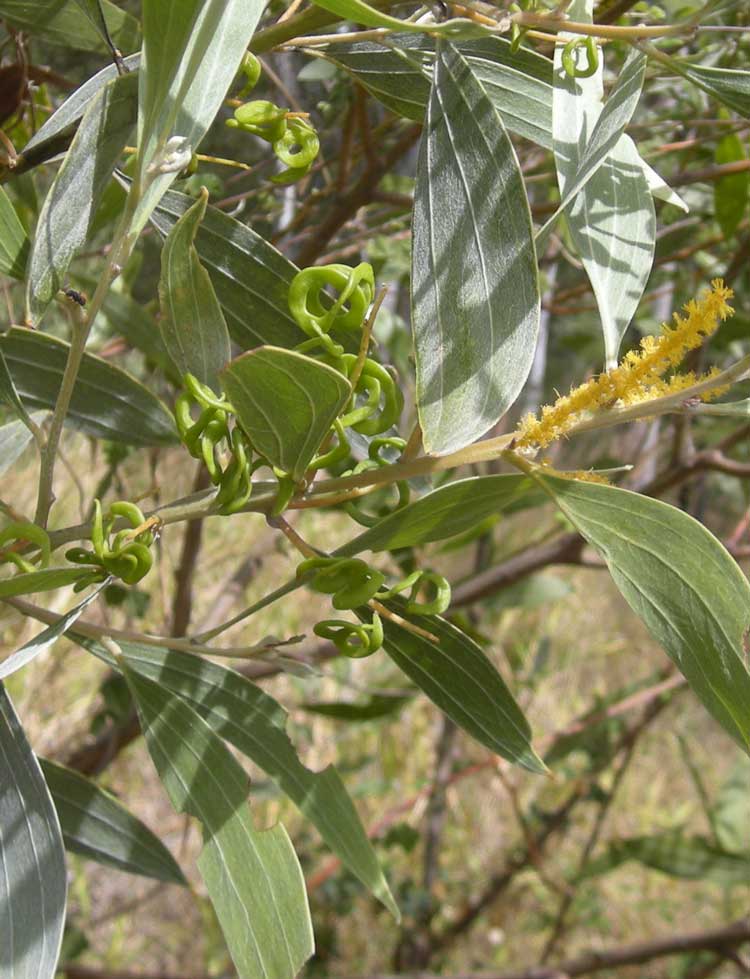
Acacia holosericea (Photo: *)
Classification System: APG IV
Superregnum: Eukaryota
Regnum: Plantae
Cladus: Angiosperms
Cladus: Eudicots
Cladus: Core eudicots
Cladus: Rosids
Cladus: Eurosids I
Ordo: Fabales
Familia: Fabaceae
Subfamilia: Caesalpinioideae
Tribus: Acacieae
Genus: Acacia
Species: Acacia holosericea
Name
Acacia holosericea A.Cunn. ex G.Don, 1832
Synonyms
Acacia holosericea var. glabrata Maiden
Acacia holosericea var. multispirea Domin
Acacia leucophylla Coville ex Sweet
Acacia multispirea Domin
Racosperma holosericeum (A.Cunn. ex G.Don) Pedley
Distribution
Native distribution areas:
Acacia holosericea
Continental: Australasia
Regional: Australia
Northern Territory, Queensland, Western Australia
Introduced into:
Burkina, Guinea, New Guinea
References: Brummitt, R.K. 2001. TDWG – World Geographical Scheme for Recording Plant Distributions, 2nd Edition
References
Primary references
Cunningham, A. in G.Don, 1832. A General History of the Dichlamydeous Plants... London 2:407.
Links
Govaerts, R. et al. 2020. Acacia holosericea in Kew Science Plants of the World online. The Board of Trustees of the Royal Botanic Gardens, Kew. Published online. Accessed: 2020 Aug 04. Reference page.
International Plant Names Index. 2019. Acacia holosericea. Published online. Accessed: Aug 04 2019.
Tropicos.org 2019. Acacia holosericea. Missouri Botanical Garden. Published online. Accessed: 04 Aug 2019.
Hassler, M. Aug. Acacia holosericea. World Plants: Synonymic Checklists of the Vascular Plants of the World In: Roskovh, Y., Abucay, L., Orrell, T., Nicolson, D., Bailly, N., Kirk, P., Bourgoin, T., DeWalt, R.E., Decock, W., De Wever, A., Nieukerken, E. van, Zarucchi, J. & Penev, L., eds. Aug. Species 2000 & ITIS Catalogue of Life. Published online. Accessed: Aug 04 {{{3}}}. Reference page.
USDA, ARS, Germplasm Resources Information Network. Acacia holosericea in the Germplasm Resources Information Network (GRIN), U.S. Department of Agriculture Agricultural Research Service. Accessed: 09-Oct-10.
Vernacular names
English: Silver-leaved Wattle, Soap Bush
தமிழ்: மான் கருவேல்
Acacia holosericea is a shrub native to tropical and inland northern Australia. It is commonly known as soapbush wattle, soapbush,[1] strap wattle, candelabra wattle,[2] silver wattle[2] and silky wattle.[3]
Description
The shrub has a spreading habit and typically grows to a height of 3 m (9.8 ft) and a width of 4 m (13 ft).[4] The large grey-green phyllodes have an ovate-lanceolate shape with a length of 10 to 25 cm (3.9 to 9.8 in) and a width of 2 to 9 cm (0.79 to 3.54 in) and are covered with white silky hairs, with three to four prominent veins. The flowers are rod-like and bright yellow, 3–5 cm long. The thinly crustaceous seed pods that form after flowering are tightly irregularly coiled and have a width of 2.5 to 4 mm (0.098 to 0.157 in).[2] The pods are 3 to 5 cm (1.2 to 2.0 in) in length and twisted and curled.[5] The shiny dark brown seeds are arranged longitudinally in the pods and have an obloid-ellipsoid shape and are 3 to 5 mm (0.12 to 0.20 in) in length with a bright yellow aril.[2] The seed is edible.[6][7]
Taxonomy
The species was first formally described by the botanist Allan Cunningham in 1832 as part of George Don's work A General History of Dichlamydeous Plants. It was reclassified as Racosperma holosericeum in 1987 by Leslie Pedley then transferred back to genus Acacia in 2006. Other synonyms include; Acacia holosericea var. glabrata, Acacia holosericea var. multispirea and Acacia mangium var. holosericea.[8] The type specimen was collected by Allan Cunninham in 1819 near Port Keats on the edge of the Cambridge Gulf.[3]
Distribution
The shrub is found in northern parts of Australia in Western Australia, the Northern Territory and Queensland.[4] The range of the bulk of the population extends from around near Derby in the Kimberley region of Western Australia to the east through the top end of the Northern Territory as far as Rockhampton in eastern Queensland. Smaller populations are found in arid regions of the Pilbara in the Hamersley Range, in central parts of the Northern Territory and in southwestern Queensland. It is found in and around ephemeral watercourses growing in gravelly sand or loamy soils.[2]
Cultivation
A. holosericea is available for cultivation by seed, although the seeds must be scarified prior to planting. It grows quickly and well in a sunny, reasonably well drained position in most soil types. It is suitable as a feature plant or as a hedge or screen plant. It has attractive foliage and fruit and can be grown in tropical areas.[4]
Uses
Indigenous Australians used the plant as a fish poison.[3] The seeds of the plant are known to be edible.[6]
See also
List of Acacia species
References
"Acacia holosericea A.Cunn. ex G.Don". Wattle - Acacias of Australia. Department of the Environment and Energy. Retrieved 11 August 2019.
"Acacia holosericea". Wattles of the Pilbara. Department of Environment and Conservation. 2010. Retrieved 11 August 2019.
F.A.Zich; B.P.M.Hyland; T.Whiffen; R.A.Kerrigan (2020). "Acacia holosericea". Australian Tropical Rainforest Plants (RFK8). Centre for Australian National Biodiversity Research (CANBR), Australian Government. Retrieved 27 May 2021.
"Acacia holosericea". Wattles - Genus Acacia. Australian National Botanic Gardens. Retrieved 10 August 2019.
Elliot, W.R., and Jones, D.L., Encyclopaedia of Australian Plants, 1982, ISBN 0-85091-143-5
Low,T., Wild Food Plants of Australia, 1988. ISBN 0-207-16930-6
NFTA 88-04 (August 1988), Acacia holosericea - A Successful Newcomer for the Dry Tropics, archived from the original on 22 March 2016
"Acacia holosericea A.Cunn. ex G.Don". Atlas of Living Australia. Global Biodiversity Information Facility. Retrieved 11 August 2019.
Retrieved from "http://en.wikipedia.org/"
All text is available under the terms of the GNU Free Documentation License

